|

The Mulch - Ones to watch in 2009
One’s to Watch in 2009…
I asked Winchester plantswoman, Jane Hughes, to list top three star performers in her garden last year …
 Tithonia rotundifolia ‘Torch’ Tithonia rotundifolia ‘Torch’
“Monty Don first drew my attention to this robust annual with vibrant orange flowers. It made a real splash in the hot border and coped well with the dismal wet summer, flowering freely for months. Cosmos ‘Purity’ is the ideal partner: equally enduring, but a light, graceful contrast with Torch’s solidity.”
 Lathyrus odorata ‘Matucana’ Lathyrus odorata ‘Matucana’
“These traditional, highly scented sweet peas scrambled up a wigwam in a corner of the potato patch. They produced an abundance of deliciously perfumed violet and purple flowers faster than I could keep up with picking them. Irresistible to insect and human visitors.”
 Ricinus communis ‘Carmencita’ Ricinus communis ‘Carmencita’
“This handsome plant with large, red-bronze leaves gave glamour and depth of colour to my hot border until October. Red stems and crimson seed pods enhance its exotic appearance. A Christopher Lloyd favourite; gratifyingly quick and easy to grow. “
… seed available from www.sarahraven.com at £1.95 per packet
Brown Tips, Green Shoots
After the coldest winter in the UK for more than a decade, it’s interesting to see which plants coped well with prolonged periods below or near to freezing and which didn’t like it at all. In my garden in balmy Southampton, temperatures dipped to -5ºC – the lowest temperature I’ve recorded here in 13 years. Other parts of Hampshire recorded a mercury shrivelling -10ºC.
With my banana clump (Musa basjoo) only lightly wrapped back in November, I was concerned that my border of tender exotics (including Cannas, Hedychium, Dahlias etc.) would run out of luck after five or more years of benign weather. It’s now the end of March and the bananas have come through the winter tattered but relatively unscathed.
The big shock is that the Australian Bottlebrush (Callistemon citrinus) has suffered badly. Checking minimum temperatures for plants (in Hugo Latymer’s excellent book ‘The Mediterranean Gardener’), the Bottlebrush should be able to cope with temperatures as low as -6ºC and the Banana -5ºC. Perhaps the flimsy, fleecy wrap saved the bananas after all.
For more info: www.gimcw.org/books/tmghl.cfm
In A Flap Over Energy Saving
By harnessing the natural, renewable and freely available resources in our outdoor spaces (the fresh air, wind, sunshine, insects and creatures that inhabit our garden etc.) we reduce our carbon footprint, our reliance on fossil fuels and our impact on the environment.
I like to include retractable or foldable washing lines, compost bins and water butts in my garden designs (where they aren’t in place already) to prompt a discussion about how my clients might benefit from the (free) power of the sun and wind in reducing reliance on some of the power-hungry activities around the home.
Did you know that, of all domestic appliances, tumble dryers are the most energy-hungry? The CO2 emitted in just one week from an average tumble dryer amounts to almost 7.5kg (or 390kg / 0.39 tonnes per year).
Using a washing line instead of a tumble dryer would save the same amount of CO2 in a year that a 3½ hour flight (a distance of 1500 miles or 2500 km) consumes.
All we would need to do is adjust our washing habits a little to anticipate good drying weather and coincide wash days with windy or dry days and let nature take care of the rest.
If you have a covered area or a car port, you could hang a line under cover for rainy or showery days. A ‘big ask’ maybe, but worth the effort if it reduces electricity bills and carbon emissions.
A retractable or foldable frame washing line can extend just enough line to suit the amount of washing you have. It is also an ideal solution for those of us who find rotary and permanent washing lines visually obtrusive in the garden.
Australian company, Addaline, supply a foldable and extendable metal washing line frame that can be located unobtrusively along a convenient boundary or wall. It folds down after use into a slimline frame.
More carbon-saving ideas at: www.foe.co.uk, Addaline foldable washing line frames and other washing line styles at: www.ecowashinglines.co.uk
 < Blowing in the Wind < Blowing in the Wind
A retractable washing line avoids the visual disturbance of a permanent washing line and accompanying
runway-straight path
 Frozen Assets > Frozen Assets >
Could the recent prolonged cold winter signal the end of our love affair with growing tender exotics outdoors?
Comfy with Comfrey
If there’s one plant well worth the title ‘wonder plant’, it has to be Comfrey (Symphytum officinale).
Known to early herbalists as ‘knitbone’, its properties range from stemming bloodflow to curing stomach ulcers and burns. If you are a smallholder, you have probably noticed that hens and pigs love it and it can be a valuable addition to their diet.
Comfrey contains high levels of all the NPK nutrients, due to its extensive, fleshy root system that draws these nutrients up from deep underground.
If you grow a patch of Comfrey, choose the site carefully to begin with as it is very difficult to eradicate once it’s established (not that you will want to!).
It will grow happily in full sun or shade and prefers soggy to dry soil conditions but needs very little attention once it’s settled in.
In spring, the first cut is traditionally used to line the potato (or bean) trench (about 2kg per 30cm of row) and the second cut is used to start a batch of liquid feed. You may be lucky enough to make two more cuts in a season.
Tomatoes are also said to benefit from a mulch of wilted Comfrey leaves, reporting increased yields (it has higher nitrogen and potash levels than Tomorite). So, go on, get comfy with Comfrey – you won’t regret it!
www.allotment.org.uk/vegetable/comfrey/index.php
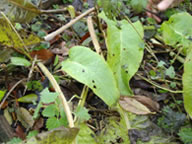 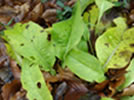 < Find a spare patch of soil and grow a hard-working clump of Comfrey < Find a spare patch of soil and grow a hard-working clump of Comfrey
Colouring In…
It’s tempting to think that all the colourful splashes in the garden should be provided naturally by flowers, seedheads and leaves. But this can be a tall order for many planting schemes, leading to higher maintenance requirements (including watering, feeding and pruning), exhausted or overblown borders and gaps in display at key moments in the year.
In year-round gardens, I often co-opt colour into the garden via wood stain, painted walls and other features to support the colours provided by the planting scheme.
In my shady rear yard area, for example, I painted the walls a warm shade of orange by mixing two Dulux Weathershield colours together. This backdrop helped to lift the recent winter plant display of Cyclamen hederifolium, and white and green variegated Carex Oshimensis ‘Evergold’ and silver leafed Bacopa. The terracotta wall pots (made by Jonathan Garratt at Hare Lane Pottery) also work well against this warm colour.
Another interesting colour combination for wooden structures is ‘Rich Red Cedar’ (Duck’s Back Woodstain) and ‘Holly’ (Cuprinol Garden Shades), producing the characteristic ‘zinginess’ of two opposite colours in the colour wheel. Needless to say, the planting schemes need to be correspondingly bold and strong.
www.diydata.com/planning/colour/colour.php
Cuttings…
Carbon-Negative Cement Trial
Novacem has invented a new form of cement which, it claims, absorbs CO2 as it sets. Novacem claims that a tonne of the new cement can absorb around 0.6 tonnes of CO2 over its lifetime compared to an average 0.4 tonnes of CO2 emitted by a tonne of normal cement. The process of manufacturing cement accounts for 5% of the world’s carbon emissions. See: www.buildstore.co.uk/news/
National Garden Scheme Garden in Hythe
After a successful series of garden open days in 2008, raising nearly £2,500 for charity, garden design clients, Mr and Mrs York, are opening their garden again this year. Search for ‘Atheling Villas’ at www.ngs.org.uk.
Check the Robinia
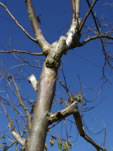 Check your Robinia pseudoacacia for signs of stunted growth, dieback or premature leaf drop. Landford Trees warn of a bacterial infection spreading across the south of England affecting just Robinias. Check your Robinia pseudoacacia for signs of stunted growth, dieback or premature leaf drop. Landford Trees warn of a bacterial infection spreading across the south of England affecting just Robinias.
www.landford-trees.co.uk
‘Seeds Blong Yumi’
Seed Savers have recently released a DVD, “Our Seeds: Seeds Blong Yumi” celebrating the seed keepers around the world. The film has received wide acclaim in Australia and the Pacific regions. See trailer at: www.seedsavers.net/
Going for Gold
The RHS has teamed up with the Government to run a competition to design the ‘Great British Garden’ for the London 2012 Olympic Park. Experts will select 12 regional finalists and a public vote will decide the winner. To download an application form, go to: www.rhs.org.uk
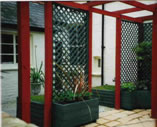 < Red and Green Backdrop < Red and Green Backdrop
The posts and trellis screens in this Winchester courtyard garden were stained in contrasting shades of Rich Red and Dark Green (‘Holly’). Apple and lime green work really well with this colour combination and anything with bronzey-orangey tones will appear amplified.
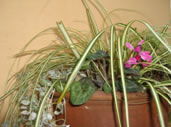
> Orange is a great colour to have behind almost every other shade you’ll find in the garden. Orange appears warm and cheerful on even the dullest day and is an excellent choice for shady areas. Orange is ideal for lifting the effect of variegated colours, bronzes and silvery greens and whites.
|

